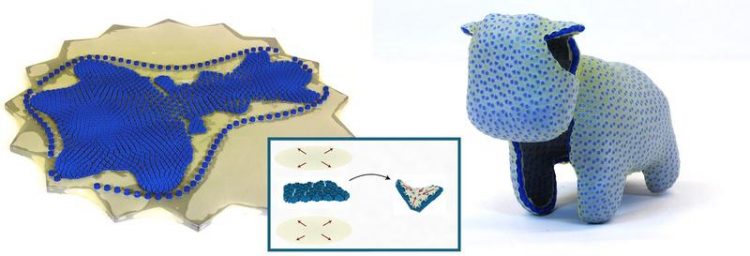Ahead of the Curve

CurveUps are flat materials that transform themselves through material forces into the desired 3D object. IST Austria
3D printers have been around since the 1980s, but we are still far from maximizing their potential. One active area of research and development is “self-actuating” objects: flat materials that transform themselves through material forces into the desired 3D object.
Previously, however, the range of objects was limited to those with sharp edges and little, if any, curvature, and the transformation methods were based primarily on folding or processes that could not be controlled very precisely (e.g. chemical reactions or inflation). Now, for the first time, a group of current and former IST Austria computer scientists have made it possible to create self-actuating, smooth, free-form objects.
In so doing, they developed both an ingenious material design and a new method of self-transformation—they call the fruits of their innovation “CurveUps”. Moreover, the team, which consists of Ruslan Guseinov, Eder Miguel, and Bernd Bickel, developed the computational tools to take a user-provided 3D model and automatically create a 2D flattened template that, upon release, transforms into the original 3D version.
The goal of the project was ambitious in a number of ways. First, it is very challenging to obtain a final 3D object that is mechanically stable. Moreover, the team had to develop a controllable mechanism to accomplish this. “I experimented with so many different materials and methods before coming up with our current design,” says first author Ruslan Guseinov. CurveUps are made up of tiny tiles sandwiched between pre-stretched latex layers. During the transformation process, the tension in the latex pulls the tiles together joining them into a continuous shell.
An innovative design and transformation method were only part of the team’s contribution, however. With these ideas in hand, the team focused on developing tools to create the 2D templates for printing. In particular, their program takes a user-supplied 3D form, and automatically generates a 2D tile layout, including the orientation, location and shape of each tile and connecting pins. However, as even small models will have hundreds or thousands of individual tiles, this represents an optimization problem of tremendous proportions—infeasible, on any personal computer. To get around this, the group implemented a two-step optimization procedure, which first gives an approximate solution, then performs local refinements before producing a final template. The entire procedure, from 3D model to a CurveUp, can be viewed online in the video linked below.
CurveUps are not just technically and mathematically impressive, they represent an important breakthrough in terms of 3D printing. “Our research is a step toward the development of new fabrication technologies: there have been many advances in flat fabrication, for instance in electronics, that have previously been limited to 2D shapes,” Ruslan Guseinov explains. “With CurveUps, we make it possible to produce 3D objects empowered with these same technologies, pushing the limits of digital manufacturing far beyond the current state.”
Bernd Bickel agrees: “There is a great deal of knowledge in terms of 2D printing technology, and we connect these capabilities with those of 3D objects. This is an extremely exciting area of 3D printing research, and the group is actively working to expand the possibilities even further.”
Ruslan Guseinov is a 3rd-year PhD student in the Computer Graphics and Digital Fabrication group at IST Austria. Eder Miguel, previously a postdoc in the group, is now a postdoc at Rey Juan Carlos University. The group is led by Assistant Professor Bernd Bickel, who joined IST Austria in 2015. The paper describing the work will be presented at this year’s SIGGRAPH in Los Angeles, California, one of the world’s premier conferences on computer graphics and interactive techniques.
Weitere Informationen:
http://visualcomputing.ist.ac.at/publications/2017/CurveUp / Link to research project
https://www.youtube.com/watch?v=OSo1HZFhVaU / Video: CurveUps: Shaping Objects from Flat Plates with Tension-Actuated Curvature (SIGGRAPH 2017)
Media Contact
All latest news from the category: Information Technology
Here you can find a summary of innovations in the fields of information and data processing and up-to-date developments on IT equipment and hardware.
This area covers topics such as IT services, IT architectures, IT management and telecommunications.
Newest articles

First-of-its-kind study uses remote sensing to monitor plastic debris in rivers and lakes
Remote sensing creates a cost-effective solution to monitoring plastic pollution. A first-of-its-kind study from researchers at the University of Minnesota Twin Cities shows how remote sensing can help monitor and…

Laser-based artificial neuron mimics nerve cell functions at lightning speed
With a processing speed a billion times faster than nature, chip-based laser neuron could help advance AI tasks such as pattern recognition and sequence prediction. Researchers have developed a laser-based…

Optimising the processing of plastic waste
Just one look in the yellow bin reveals a colourful jumble of different types of plastic. However, the purer and more uniform plastic waste is, the easier it is to…



